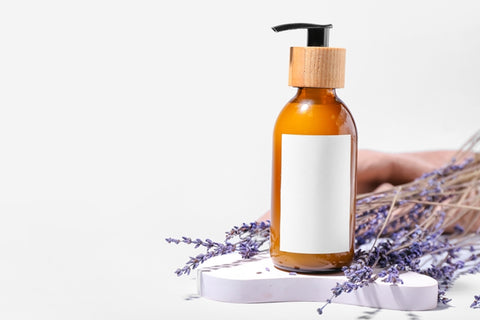Who doesn't like convenience of body wash gels? They contribute to a more relaxed and pleasant bath. However, they are not always affordable, and it is not always feasible to select one from the market and then play with it. Isn't it best to stick to tried-and-true methods like using natural ingredients?

Some of the items we use to keep our bodies clean are really doing more damage than good to them. If you are looking to clean up your routine then produce your own natural homemade body wash would be far less expensive than purchasing natural choices from the market.
Why Should You Use Homemade Body Wash?
Unlike store-bought body washes, homemade body washes are free of chemicals and synthetic smells. You can make a natural, preservative-free, moisturising body wash in minutes with this recipe!

You won't be missing out on any of the rich, creamy lather you get from store-bought body washes if you use these natural components in your body wash. These body washes will provide deep exfoliation and hydration to your skin.
DIY Body Wash Recipes - Step By Step
It's simple to prepare a hydrating and natural DIY body wash. These moisturizing homemade body cleanser are good enough to protect your body and also create a rich lathering with natural mix of ingredients. Try these antibacterial and skin friendly homemade body wash recipes:
1. Homemade Coconut Body Wash
Coconut oil, in particular, has significant antibacterial qualities and is believed to help prevent acne. Its topical use might help keep your skin supple and eliminate dead skin cells.

Ingredients:
- ½ cup coconut oil
- ⅔ cup unscented liquid castille soap
- 1 tsp raw honey
- 2 tsp glycerine
- 3 tbsp jojoba oil
- 5 drops lavender essential oil
Recipe:
- Take a bottle and pour 1/2 cup coconut oil into it to make homemade body wash.
- Add 2/3 cup unscented liquid castile soap to the mix as well.
- Add 1 teaspoon raw honey, 2 teaspoons glycerin, 3 tablespoons jojoba oil, and 5 drops of lavender essential oil after that.
- After thoroughly mixing all of these components, your body wash is ready.
- All you have to do is pour it into a bath sponge and use it.
2. Homemade Shea Butter Body Wash
For ages, shea butter has been utilised as a cosmetic component. It's a terrific for smoothing, calming, and conditioning skin because of its high content of vitamins and fatty acids, as well as its easy-to-spread consistency.

Ingredients:
- ½ cup shea butter
- ½ cup sunflower oil
- 1 cup liquid Castille soap
Recipe:
- 1/2 cup shea butter, 1/2 cup sunflower oil, and 1 cup liquid Castile soap are required for this recipe.
- In a skillet, melt the shea butter, then add the remaining ingredients and stir thoroughly.
- Once completed, place it in a jar and use it as and when needed.
3. DIY Almond Oil & Vitamin E Oil Body Wash
Almond oil is high in vitamins A, D, E, K, omega fatty acids, and minerals, all of which are beneficial to skin. These ingredients may aid in appearance of tighter, clearer, and moisturized skin.

Ingredients:
- 1 cup Castille soap
- 1 cup distilled water
- 3 tbsp. sweet almond oil
- 2 tsp vitamin E oil
- 20-40 drops of your favourite essential oil
Recipe:
- 1 cup Castile Soap, 1 cup Distilled Water, 4 TBSP Sweet Almond Oil, 2 tsp Vitamin E Oil, 20-30 drops Essential Oil of Your Choice are all needed for this recipe.
- In a container, combine all of the ingredients and gently shake to combine.
- Use when desired.
4. Homemade Lavender Oil Body Wash
Lavender essential oil may help decrease redness, soothe and relax the skin, and quickly heal small cuts and scrapes, as well as any rashes, thanks to its anti-inflammatory, antifungal, antibacterial, and detoxifying properties.

Ingredients:
- 30 drops lavender essential oil
- 1 cup distilled water
- 1 cup unscented liquid castille soap
- 3 tbsp coconut oil
Recipe:
- You'll need 30 drops of lavender essential oil, distilled water, Unscented Castile Soap, and coconut oil to prepare this body wash.
- In a blender, combine everything except the Castile Soap and Lavender oil.
- After that, mix all of the ingredients and set the mixture aside for a bit before using.
5. Homemade Rosemary Oil Body Wash
Rosemary Oil helps to reduce oil production by hydrating skin. It gives skin an antimicrobial surface, which helps to keep acne at bay. Antibacterial qualities of rosemary oil are good for skin diseases like eczema.

Ingredients:
- 30 drops rosemary essential oil
- 1 cup distilled water
- 1 cup unscented liquid castile soap
- 3 tbsp coconut oil
- 1 tbsp pinhead oats
- 1 sprig of rosemary
- 2 tsp citric acid
- 1 tbsp guar gum
- 1 tbsp honey
Recipe:
- You'll need pinhead oats, a sprig of rosemary, citric acid, distilled water, coconut oil, castile soap, guar gum, and honey to prepare this DIY body wash.
- 30 drops of rosemary essential oil are also required.
- Combine all of the ingredients and place them in a sterile container.
- Make sure it isn't exposed to direct sunlight.
Conclusion
These gorgeous body washes will lather well and give a pleasant aroma that reminds that will keep you refreshed all day long. As the water beads up, you can feel the all-natural ingredients forming a protective barrier to your skin.













 Sign in
Sign in Register now
Register now My Reward Points
My Reward Points









